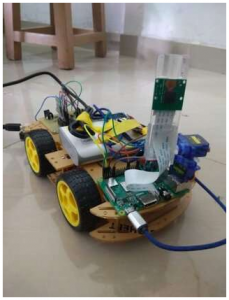Two Indian Students Build Robot For Virtual Navigation Of Remote Environments
These robots might be used to monitor secluded or dangerous places like during an earthquake or other natural disasters from a safe distance.

Two students who graduated from VR Siddartha Engineering College in Kanuru, India, have created a virtual telepresence robot that permits users to ascertain what's happening during a remote location as if they were actually there. Their project, supervised by Professor V.N. Prudhvi Raj, provides a valuable example of how robots may be used to capture video data in real time and monitor places that are momentarily or permanently inaccessible to humans.
"I have recently graduated in electronics and instrumentation engineering from VR Siddhartha's Engineering College," Mani Babu Gorantla and Grandhi Sathya Venkata Krishna, the two researchers who created the robot, told TechXplore. "We developed this robot as our final project. It was inspired by an article about telepresence robots that we read in a magazine called Electronics For You."
Objective:
The main objective of the recent study by Mani Babu, Krishna and Prudhvi was to permit users to visualize things that are happening in remote locations in real-time.
Concept:
They created a robot with an onboard camera and Wi-Fi capabilities, which captures videos and allows users to observe them instantly on their smartphone, on a web browser or via computer game (VR) headsets.
"Whatever is captured by our robot's camera are often transmitted on to a user's smartphone, which may even be placed during a VR box or headset, allowing users to look at the environment in VR as if they were actually navigating it," Mani Babu and Krishna explained. "The user feels as if he/she is present at that location, because the robot's onboard camera moves in accordance with the user's head movements."
Working:
Initially, the researchers controlled the robot's movements and streamed the videos captured by its camera using an Arduino microcontroller and a Raspberry Pi, a minicomputer with no screen. They wanted to make sure that the robot's movements matched a user's head movements. To achieve this, they leveraged accelerometers and gyroscopes (i.e., sensors which will determine the position and orientation of an object), which are key components of most existing devices.
Essentially, the data collected by the accelerometers and gyroscopes during a user's smart phone is employed to determine his/her head movements. This data is transferred to a Raspberry Pi device then used to control the movements of the robot's camera, to make sure that they match a user's head movements.
"We used Arduino to maneuver our robot back and forth, as well as right and left," Mani Babu and Krishna explained. "We decided to use two different controllers (Raspberry Pi and Arduino) because while Raspberry Pi also can control the robot's motor, it might have higher RAM; thus, we are giving it longer to process the video and stream it. This puts less burden on Raspberry Pi."
Improvements:
Although the primary prototype of the robot was built using Raspberry Pi and Arduino, subsequently, the researchers substituted these two components with a more sophisticated device called MyRIO. MyRIO is a portable device which will serve both as a data processor and controller; thus, it can combine the capabilities of Raspberry Pi and Arduino devices.
"Initially, we used Raspberry Pi and Arduino to control the robot, but eventually, we decided to try using MyRIO instead, which is costlier than the other two, but at the same time features a higher processing capability; thus, it can simultaneously fulfill the tasks of Raspberry Pi and Arduino," Mani Babu and Krishna said. "Our robot could have many applications. Within the context of our university, for instance , it might be employed by the principal or a head of department to watch corridors."
Future Plans:
While Mani Babu, Krishna and Prudhvi aren't currently aiming to commercialize the robot they created, their work could serve as an idea for other research teams, ultimately resulting in the event of comparable virtual telepresence robots. In the future, these robots might be used to monitor secluded or dangerous places from afar (e.g., trying to find survivors during an earthquake or other natural disasters), to virtually view home or office environments when one is on holiday, and for a variety of other applications.
Source: TechXplore







